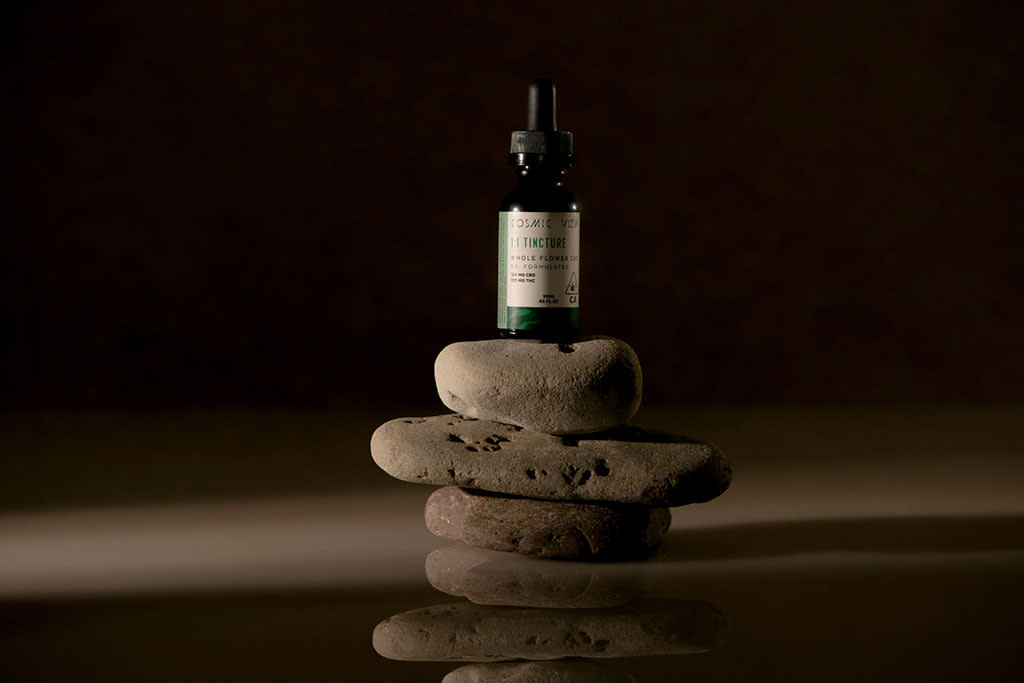Cannabis and Women's Health

Guest written by Christine and Nicole Skibola of Cosmic View.
Many women suffer from a unique set of health challenges from menstrual pain and hormonal imbalance to migraines, fertility and cancers. Increasingly, we are seeing a shift toward holistic health solutions that treat and prevent some of these conditions. This blog post explores research-based safe and effective options for cannabis in addition to other lifestyle factors that are simultaneously protective and can be used to treat specific health conditions. It also relies on anecdotal data that we know about “whole plant medicine.” The increased efficacy of cannabinoids such as CBD, CBDA and THC when left intact with the full range of cannabinoids that naturally occur in the plant create what we know as “the entourage effect."
Over the next two posts, we will cover the treatment and pain-relieving effects of cannabis on dysmenorrhea (painful periods) and endometriosis, and its potential in the prevention and treatment of female cancers.
DYSMENORRHEA AND ENDOMETRIOSIS
Dysmenorrhea is a common condition among young menstruating women. It is defined as menstrual pain, which sometimes may be so severe, as to be completely debilitating. Sadly, women’s pain has historically been ignored or discounted by medical professionals, so this complex disease is only now receiving the attention it deserves.
Endometriosis affects approximately 176 million women worldwide, or 1 in 10 women of childbearing age. Endometriosis is a painful debilitating disease where the endometrium forms innervated growths outside of the uterus such as in the fallopian tubes, ovaries (forming cysts) and elsewhere in the body. Endometriosis results in abnormal immune responses including the release of pro-inflammatory and growth factors that promote further spread of the disease. If left untreated, it can cause infertility, painful sexual intercourse, and increase a woman’s risk of endometrial cancer.

TREATMENT FOR ENDOMETRIOSIS
The current western medical treatment options are surgery, NSAIDs, narcotic pain medications and hormonal therapies with many adverse side effects. While cannabis has been used for centuries to alleviate pain, it’s only been more recently that scientists are beginning to understand some of the mechanisms involved. Research on endometriosis is limited, but the studies and anecdotal evidence are revealing the potential of cannabinoids to treat and alleviate symptoms related to this chronic disease.
THE ENDOCANNABINOID SYSTEM AND NERVE PAIN
The body’s natural endocannabinoid (EC) system plays an important role in the healthy functioning of the body including the female reproductive tract, as well as in the development of and pain associated with endometriosis. Studies show that dense nerve bundles produced in the endometriotic lesions associated with magnified pain express high levels of the EC receptor, CB1[1].
Anandamide the body’s own form of THC, as well as THC itself, can activate CB1 and block the nerve pain. Unfortunately, Anandamide gets quickly degraded in the body by an enzyme called FAAH. The good news is that CBD inhibits production of FAAH so it can also play an important role in reducing pain, allowing the pain-relieving Anandamide to stay in the body for longer. CBD is also able to desensitize pain through various other mechanisms.
ANTI-INFLAMMATORY EFFECTS OF CANNABINOIDS
Women with dysmenorrhea and endometriosis also have higher levels of pro-inflammatory prostaglandins (produced by “COX-2 enzymes”) that stimulate uterine contractions and result in debilitating pain. Similar in action to NSAIDs, research has shown that CBD and CBDA can inhibit COX-2 and thereby reduce the production of prostaglandins, easing menstrual pain.[1] CBD also dampens the production of other pro-inflammatory molecules in the body such as IL-6, IL-8 and TNF-alpha by increasing levels of Anandamide[2]. THC also modulates cytokines by binding to CB2 receptors and preventing the release of pro-inflammatory molecules from immune cells.
In animal studies of acute inflammation, researchers found that the acidic form of CBD (CBDA) or THC alone, as well as very low doses of combined CBDA and THC, exerted anti-inflammatory and pain-reducing action.
EFFECTS OF THC ON CELL PROLIFERATION AND MIGRATION
Most of the current literature reports the anti-proliferative effects of THC on the spread of endometriosis. However, it should be noted that in endometrial adenocarcinoma cancer cells, researchers found that low levels of THC actually increased cell migration, while at higher concentrations (micromolar range), THC decreased cell migration[1], which could also be true in the case of endometriosis. Researchers also found that low level CBD was able to inhibit the pro-migratory action of THC. This suggests that women who self-medicate with THC should consider adding CBD to their regimens.

RECOMMENDATIONS FOR WOMEN SUFFERING FROM ENDOMETRIOSIS:
-
There are many benefits to using CBD and THC over NSAIDs for pain relief to avoid the long-term adverse effects on the GI tract and on liver function.
-
Find a whole-plant extract rich in CBD, but also containing some THC. Ratios that have been anecdotally found effective for endometriosis are high in CBD, such as a 3:1 or 20:1 CBD to THC tincture. These formulas would be effective for day-to-day maintenance by decreasing endometrial inflammation and lesions over time. We generally recommend high-quality tinctures that contain medicinal grade extracts and do not contain any sugar or additives that could contribute to inflammation.
-
Keep a high THC ratio formula around (tincture or flower) for pain relief. Note that inhalation is the fastest delivery method and can be effective for severe, sudden pain. Remember that for endometriosis, THC should be balanced with some CBD (perhaps a 1:1 ratio).
-
Watch your diet! Because endometriosis is an inflammatory disease that is estrogen-dependent, women can alleviate symptoms by reducing inflammation (by avoiding dietary sugar, red meat, alcohol; eating more vegetables that are high in anti-inflammatory polyphenols) and avoiding highly estrogenic foods (soy, flaxseed, etc – For more information, see my paper on flavonoids). Women with chronic endometriosis should consider a vegan diet and integrate other natural anti-inflammatories such as cruciferous vegetables, green juices and flavonoid-rich foods.
-
Eat foods that are rich in a naturally occurring terpene called beta-caryophllene. Beta-caryophllene is a powerful anti-inflammatory with anti-cancer properties and can be found in basil, oregano, cinnamon and black pepper. It also naturally occurs in certain cannabis strains.
-
Melatonin: As a neurohormone, melatonin has a number of important bodily functions including regulating circadian rhythms and reproduction. It is also a powerful antioxidant and free radical scavenger, and as such has anti?inflammatory action in the body including the endometrial tissues. It is also anti-estrogenic. As such, it can be highly beneficial in treating endometriosis.
-
Fucus vesiculosus is an edible brown seaweed that I have done laboratory research on for years. I’ve shown that it has anti-estrogenic action and that it can effectively reduce pain and associated heavy menstrual bleeding in women with endometriosis. I’ve also shown its anti-estrogenic and anti-cancer effects in other studies.
-
Acupuncture: The current literature suggests that acupuncture can be beneficial in the treatment of endometriosis-related pain.

 First, create your Sava account.
First, create your Sava account. Your $40 discount will apply automatically on your first order.
Your $40 discount will apply automatically on your first order.